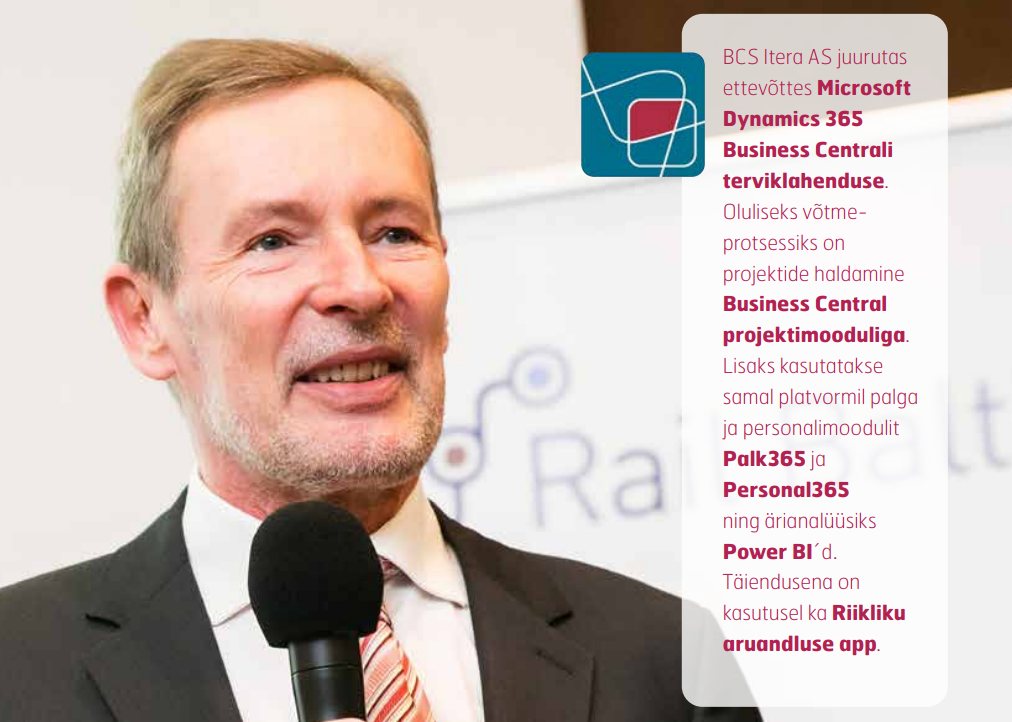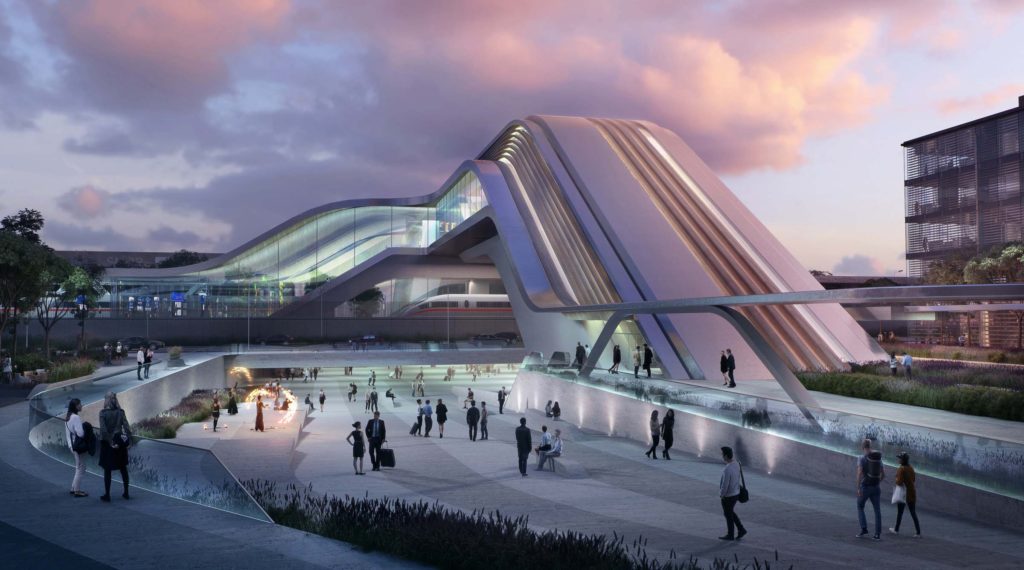Rail Baltic Estonia: The best of the best will inevitably meet
The Rail Baltica high-speed rail connection linking Estonia to central and western Europe is a major project that requires the best enterprise resource planning software in order to succeed. That is why the project team has partnered with BCS Itera, who won the public contract of Rail Baltic Estonia OÜ with their Dynamics 365 Business Central software offer.

‘This last year has been quite turbulent – Rail Baltica is an extremely multi-layered project, which means that we can really talk about challenges rather than difficulties. I realise that this may sound clichéd, but the co-ordination of all these various activities and processes, which involve numerous parties and which all move at their own pace, requires no small amount of brainwork,’ claimed Tõnu Grünberg, the chairman of the management board of Rail Baltic Estonia.
Nevertheless, he stated that the moments when you see and understand that the whole team is truly motivated to work towards a common goal, and that people are able to put forth their best effort despite the long and difficult workdays, are a joy to behold. ‘Another wonderful thing is that despite all obstacles we are still moving forward with the construction of Rail Baltica: several construction contract notices have been published and we will soon be able to start building railway junctions, for example. The design of the main route is in full swing and we are intensively engaged in addressing environmental issues. All such busy workdays, even when limited to just small victories and incremental progress, are deeply enjoyable.’
A LARGE ENTERPRISE
As of this summer, Rail Baltic Estonia’s team comprises 47 people, who are contributing to the success of the company’s mission: to develop a fast, safe, and environmentally friendly railway connection with neighbouring countries and the rest of Europe. ‘I believe that organisational culture – how it is consciously created and how it self-reproduces organically – really takes off when the purpose of the organisation’s activities is clear and everyone understands it in the same way. With ambivalent goals, it is considerably more difficult,’ Grünberg noted. He added that Rail Baltic Estonia as an organisation values competence and smarts, honesty and respect towards oneself as well as others, and flexibility in adapting to new situations.
Keeping pace with the organisation’s development needs is certainly also important: the team has doubled in size over the year, and growth does not appear to be slowing as yet, as the company continues to look for skilled project managers and engineers. Meanwhile, they are also developing training programmes and making improvements to process management.
‘We are currently in a unique situation where we operate, partly now and looking ahead, in the railway sector, but in terms of core activities classify rather as infrastructure and real estate developers,’ Grünberg observed. ‘If the railway is completed one day, we can take on the role of infrastructure manager, but Rail Baltic Estonia will never become an operator like Elron. We will not be running any trains or rolling stock. Our challenges are ultimately largely related to the co-ordination of wildly different activities and the parties carrying them out.’
The company’s goals for this year are primarily related to the construction of junctions and the publishing of construction contract notices. The plan is also to finish the detailed design documentation for the Ülemiste and Pärnu international terminals and start calling for tenders for these two major facilities within the year. In addition, 2021 is an important year for the project of local Rail Baltica railway stops, the design process of which will also be launched this year.
A GOOD SOFTWARE SOLUTION IS ONE THAT MEETS THE USERS’ PERSONAL NEEDS
Since Rail Baltic Estonia as an entity is required to organise public procurements, it can be said that the final decision on the choice of ERP software was made by the public procurement procedure. ‘We researched several options on the market – it was important for us to find a complete solution that covers financial management processes and which could be easily integrated with additional IT solutions in the future. We use a number of Microsoft 365 applications in our daily work, which is why were confident that Dynamics 365 Business Central would be easy to interface with, where necessary, and compatible with potential new digital solutions,’ Grünberg explained.
Currently, the company is using the financial, contract management, and payroll and human resources modules. All of this has been interfaced with state agencies involved in state accounting, CostPocket cost reporting, electronic invoicing, and X-Road data exchange. While it is still a little early to talk about adding further modules, according to Grünberg, business analysis and project management tools cannot be ruled out.
‘Many of these solutions – especially the accounting and human resources tools – are absolutely indispensable in modern business. The solutions developed by BCS Itera that we are using make our work easier and more efficient. Having just completed the deployment phase, we received a great deal of support from Itera in learning how to use the software and tailoring it to our needs.’
Grünberg added that the partnership with BCS Itera did not really start until this year. ‘As mentioned, we usually choose our partners through a public procurement procedure. Estonia is a small country and the best of the best will inevitably meet!’
RAIL BALTICA IS MORE THAN JUST A HIGH-SPEED RAIL CONNECTION
The Rail Baltica project has made it possible to extend the tram link all the way to the airport, and the construction of a tram line to the Tallinn Passenger Port will soon follow, which means that the project will not just provide an improved means of mobility to future rail passengers but also to those who may never use Rail Baltica.
In collaboration with Tallinn Airport and Port of Tallinn, ways will be explored to make combined rail and air or rail and sea transport more efficient for passengers. For example, luggage could move smoothly from airplanes or ships to trains and vice versa, taking into account the start and end points of the whole journey. Additionally, Rail Baltica will also be used by regional trains. There will be 12 local stops in Estonia and two more international stops in Tallinn and Pärnu, which will also be employed by local trains.
Given how much faster, more convenient, and safer travel along the north–south corridor will become with the arrival of Rail Baltica, Grünberg believes that this is a universal service that is suitable for all user groups. In the future, you will be able to park your car or motorcycle on a sleeper train near Ülemiste, spend the night comfortably on board, and then continue driving from Warsaw in the morning.

WHAT’S WHAT
RAIL BALTICA
Rail Baltica is an international project involving the three Baltic States as well as Finland and Poland. It is an electrified railway connection with a track gauge of 1,435 mm (the so-called European gauge) linking Estonia, Latvia, and Lithuania, which will run from Tallinn via Riga to the border between Lithuania and Poland. The construction of facilities intersecting with the main route is due to commence on a larger scale in Estonia in 2021. Rail Baltic Estonia OÜ is the entity responsible for the development of Rail Baltica and for representing the interests of the Estonian state in the joint undertaking RB Rail AS in Estonia.